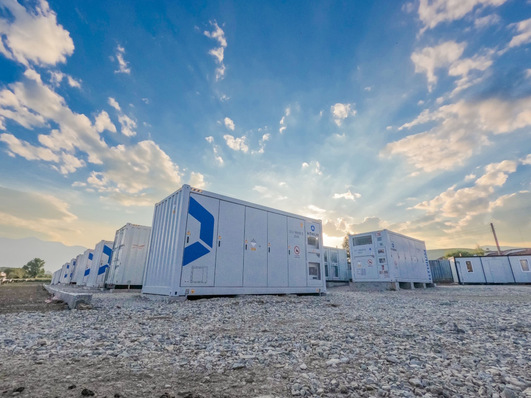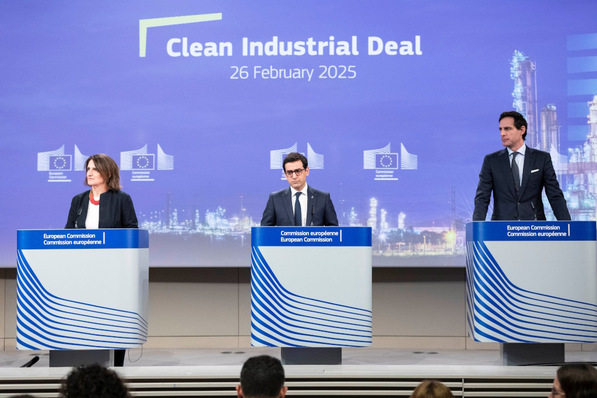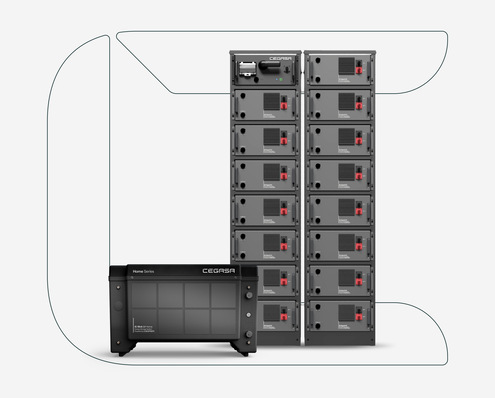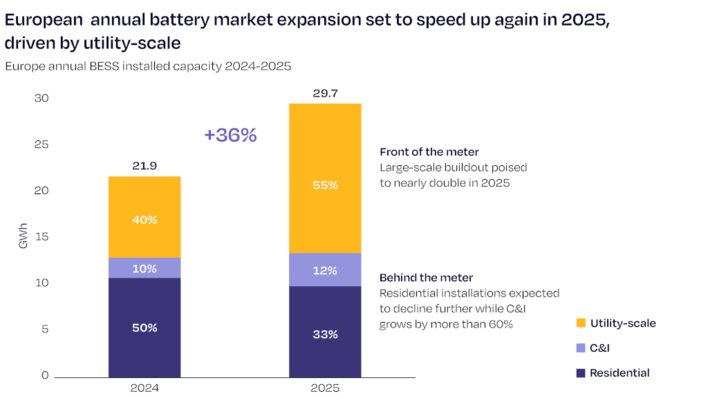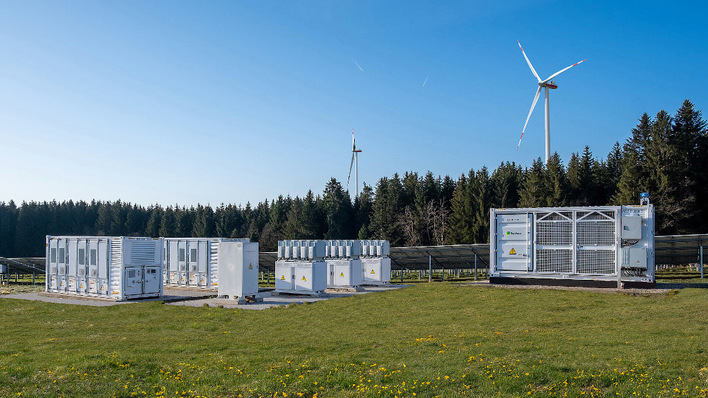The Battery Energy Storage System (BESS) market is expanding rapidly. In 2023, a total of 17.2 GWh of new BESS capacity was installed in the EU, representing a 94% increase compared to 2022. This growth correlates with the decreasing market value of renewable energies. As solar and wind generation capacity increases, the value of clean electricity declines during periods of oversupply, leading to a further rise in negative prices. Hence, storage systems that can buy cheap and abundant electricity to sell it later with a margin become increasingly attractive.
Europe sees rapid expansion of large-scale battery systems
While dispatchable electricity generation largely relies on fossil fuels, new flexibility options are gaining momentum. The high costs and emissions associated with fossil fuels have made BESS an attractive business model due to their high yields and scalability.
Efforts to expand storage capacity are underway across the EU, with Germany emerging as the fastest-growing market due to rapid renewable buildout and the phase-out of nuclear and coal. Currently, about 1.4 GW of BESS is installed, but transmission system operators report 161 GW awaiting grid connection, highlighting the sector's immense potential. However, approximately 70-80% of planned projects may not progress beyond planning stages due to developers applying for multiple connection points simultaneously. Despite this, the BESS market trajectory remains strong. BESS can serve multiple systemic functions, generating revenue through revenue stacking from electricity trading and ancillary services like frequency restoration. Additionally, BESS enhances renewable energy integration and alleviates grid congestion
Expert view – how Europe can build a resilient battery ecosystem
Can the EU manufacturing keep up with China?
As the growth of BESS in Europe continues, questions arise about where these systems are manufactured. Europe’s growing dependency on supply chains dominated by China poses significant challenges. Currently, China controls the supply chain for critical raw materials such as lithium and dominates the production of energy storage systems. With an overcapacity in battery manufacturing, China can theoretically meet the annual global demand for batteries. While this benefits project developers through lower prices, it raises concerns about the EU’s resilience and the competitiveness of its local manufacturers.
European manufacturers face structural disadvantages, such as higher costs, regulatory burdens, and limited access to infrastructure. Companies like Northvolt exemplify these challenges. Despite efforts to establish large-scale battery manufacturing, significant obstacles remain.
This does not imply that Europe should abandon its ambitions in energy storage manufacturing. Instead, achieving a sustainable and economically sound production base will require rethinking current approaches. The EU Battery Regulation is a step in the right direction, setting targets for recycling and re-use to support the sustainable scale-up of batteries.
SolarPower Europe calls for action plan to save the European PV inverter industry
Principles for the future of European battery manufacturing
Innovation: Addressing strained supply chains requires developing alternative raw materials, exploring new battery chemistries, and advancing innovative solutions to market readiness. While the race for dominance in existing battery technologies may be challenging, opportunities for innovation remain viable and essential. France, in particular, is setting a good precedent for the opportunities that innovation can bring by investing €1.5 billion in solid-state battery research.

Libattion
Circular economy: Europe heavily depends on imports of raw materials, even though substantial quantities are embedded in end-of-life products. Current recycling capacities are insufficient to meet demand, leading to unsustainable practices such as exporting shredded batteries ("black mass") to Asia for processing. Adhering to circular economy principles by extending the use of materials and promoting re-use can reduce import dependencies, enhance resource efficiency, and foster a resilient industrial ecosystem. This is a core principle of a sustainable future that Libattion is strongly committed to. Through Libattion's upcycled lithium battery storage and energy management systems, a combination of sustainable resource use and the promotion of a decarbonised energy sector becomes possible.
Addressing the manufacturing gap: The disparity between the rapid expansion of BESS and the limited ability to manufacture them domestically must be addressed. Economic returns from BESS often do not align with the high costs of local production. Regulators need to incentivize sustainable practices, such as prioritizing non-price criteria and enforcing high environmental and human rights standards, to create demand for products made in the EU. The new European Commission already put this challenge high on its agenda by announcing the Green Industrial Plan and the Competitiveness Strategy.
Long-term storage with iron flow technology
The way forward
The BESS market in Europe is poised for significant growth, driven by the increasing integration of renewable energy and the need for grid flexibility. However, addressing the challenges of supply chain dependency, regulatory hurdles, and manufacturing gaps is critical for ensuring sustainable and competitive development.
By fostering innovation, embracing circular economy principles, and supporting local production, Europe can build a robust and resilient energy storage ecosystem while reducing reliance on external supply chains. (Stefan Bahamonde/hcn)
More on Libattion




